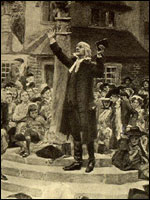
JOHN WESLEY
Bongs - Wesley at New Mills - The Preachers
John Wesley was the founder of the Methodist denomination; he was a tireless man who travelled the country on horseback delivering his message. He is estimated to have given 40,000 sermons and travelled 250,000 miles on foot or horse back in his life time. It was a denomination which found great favour in New Mills as is easily witnessed by virtue of the many chapels that at one time dotted the parish. Many, like the great chapel at St Georges Road were sadly removed in the 1970’s and 80’s, others have been converted to housing. Only the original chapel of 1766 remains as a place of worship. Standing as it does on High Street it was once at the very centre of the town.
There is no doubt that the first Methodist Society in this district was at Bongs (banks) on the hillside between New Mills and Mellor. There were services in the old fold there, led by David Taylor, years before the cause spread to New Mills. They were gloomy days for Englishmen when Wesley paid his first recorded visit to Bongs. There was war with France both on the Continent and in America. Highland claymores carried terror as far South as Derby. But Wesley went on as though nothing was happening around.
It is most likely that Wesley’s visits to Bongs, New Mills, Chinley and Chapel were at the request of John Bennett who was based at Chinley. Bennett owed his conversion to Methodism to the ministry of David Taylor, ‘the early apostle of Methodism in the Peak’ who was a native of Sheffield and was consumed with home missionary zeal. Taylor was a pioneer opening up the way for Wesley and Bennett in many places. In his desire to spread the Gospel, he was led in the direction of the Derbyshire hills, and thus it was that he came to Mellor and Bongs about 1740.
An entry in Wesley’s Journal, for Sunday, April 28th 1745 reads: I preached at five (as I had done overnight) about a mile from Altringham. At nine I preached at Stockport to a large congregation. Thence we rode to Bongs, in Derbyshire, a lone house on the side of a high steep mountain, wither abundance of people were got before us. I preached on justifying the ungodly; and his word was as dew upon the tender herb. At five I preached at Mill Town near Chapel-en-le Frith.
There is another reference to Bongs in Wesley’s Journal: ‘Tuesday May 12th 1747. I rode to Bongs and explained to a serious people the parable of the Prodigal Son. In the evening I exhorted them at Chinley earnestly to contend for the faith once delivered to the saints.
The district seems to be one of which Wesley was particularly fond, and he was back at Bongs on Wednesday, August 31st, 1748. On this occasion the Journal says ‘John Bennett showed me a gentleman’s house who was a few years since utterly without God in the world. But two or three years ago God laid his hand both upon his body and soul. His sins dropped off. He lived holy and unblameable in all things. And not being able to go without doing good, he resolved to do what he could at home. To this end he invited his neighbours to his house every Sunday morning and evening (not being near any church) to whom he read the prayer of the church and a sermon. Sometimes he had 150 or 200 of then at once. At the Bongs received an invitation from him so John Bennett and I rode down together and found him rejoicing under the hand of God and praising him for all his pain and weakness.
Bongs therefore will always be held in high regard as being the spot where the first Society was formed in this district. Down to the year 1847, preaching services were held at Bongs, but eventually the society there allied themselves to the Nonconformists of Mellor and Brookbottom.
It is said that on one visit John Wesley stayed overnight at the Bongs and on waking next morning stood by the door he commented that the view was like a vision of paradise. The name of the cottage is changed to ‘Paradise Cottage’ in memory of that visit. In 1969 the churches of the district erected Cobden Cross on the spot where it is believed Wesley had preached to a large gathering on Sunday, April 28th 1745
Methodism at New Mills began with meetings in the homes of the people, and in 1766, the first chapel was built, it stood in what was then the centre of the village, and was the only place of worship in it. The site was bought from John Hansell by James Beard Esq. and 14 others for the nominal sum of five shillings and the annual payment of ‘one peppercorn at or upon the feast day of the Annunciation of the Blessed Virgin Mary.’
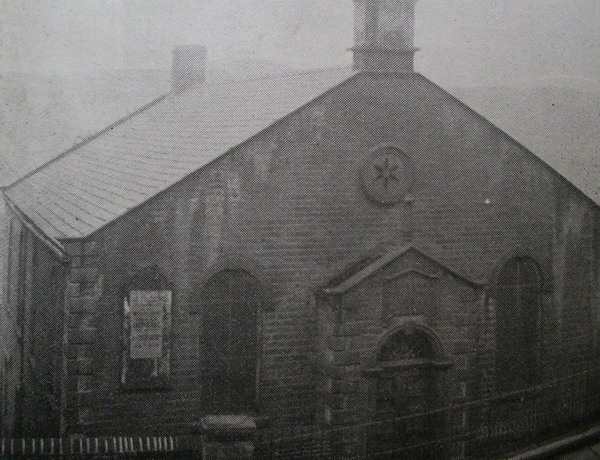
In 1808, a movement was set on foot for the erection of a new chapel. To quote an old deed ‘The chapel, from the increased populosity of New Mills and its neighbourhood, is become to small to contain the devout inhabitants desirous of assembling to hear Divine Worship there. The St George’s Road Methodist Church was built on the opposite side of the river, at Brookside, at a cost of two thousand and seventy pounds, and opened in August 1809. The site and burial ground were bought from Randle Taylor in 1809, the old chapel becoming the Sunday School.
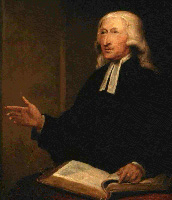 Wesley’s first visit to New Mills was in 1768, two years after the erection of the first chapel and an entry in his Journal reads: ‘I rode to the little town called New Mills in the High Peak of Derbyshire. I preached at noon in their large new chapel, which (in consideration that preaching houses have need of air) has a casement in every window three inches square. That is the custom of the country!’ Wesley’s first visit to New Mills was in 1768, two years after the erection of the first chapel and an entry in his Journal reads: ‘I rode to the little town called New Mills in the High Peak of Derbyshire. I preached at noon in their large new chapel, which (in consideration that preaching houses have need of air) has a casement in every window three inches square. That is the custom of the country!’
On Tuesday, April 7th 1772, Mr Wesley rode from Manchester. He writes ‘I went to New Mills. Not withstanding all the rain, the house was well filled for nothing can hinder this lively, earnest people.’ On Easter Tuesday, April 5th 1774, Mr Wesley again visited New Mills and left on record that ‘About noon I preached at New Mills, to an earnest, artless, loving people and in the evening at poor, dull, dead Stockport. Exactly two years later, on Wednesday, April 3rd, 1776, Mr Wesley took care to pay New Mills another visit, for having visited Macclesfield he says: ‘Having climbed over the mountains, I preached at New Mills, in Derbyshire. The people here are quite earnest and artless, there being no other public worship in the town but at our chapel; so they go straightforward, knowing nothing of various opinions and minding nothing, but to be Bible-Christians.'
Imagine the whole town assembled for worship in the old chapel, and trace from it the origin of all the Protestant congregation of today in New Mills from Wesley’s visit.
Thursday the 1st of April 1779 was another big day when Mr Wesley came from Macclesfield, and lifted up his voice here. The cause was then winning its widening way on all hands, for he says: ‘About one I preached at New Mills in Derbyshire. A commodious preaching house lately built has proved a blessing to the whole country. They flock together from every quarter, and are thankful both to God and man’. This was the Thursday before Easter that year. The Easter of 1782, three years later, again found Wesley at Macclesfield, and on the Monday he rode over to Chapel-en-le-Frith, such a journey he had seldom had unless it was in the middle of January. There was wind snow and rain in abundance and the roads were almost impassable, but he leaves it on record that on Easter Tuesday, April 2nd 1782 ‘I preached at New Mills to as simple a folk as those at Chapel. Perceiving that they had suffered much by not having the doctrine of perfection clearly explained, and strongly pressed upon them. I preached expressly upon this head, and spoke in the same effect in meeting the Society. The spirits of many greatly revived and they are now going on to perfection.
Mr Wesley evidently delighted to visit his people here, for at the age of 85, when all his bodily strength was failing he left Macclesfield at five o’clock on Easter Monday morning , April 7th 1788 ‘and with a deal of difficulty got to New Mills, the road over the mountains being barely passable. But the earnestness of the congregation made amends for the difficulty of the journey. They were all athirst for God!.’ on this occasion Mr Wesley stayed in New Mills for two days and then went on to what is now known as Hazel Grove, for he says ‘ at noon I preached in the Chapel at Bullocksmithy, one of the most famous villages in the country for all manner of wickedness. But there is a change for the better already and a fair prospect of a much greater.’ Mr Wesley died on March 2nd 1791.
The old Manor House by the Brookside where James Beard Esq., one of the first trustees, lived, was a fine old place and it sheltered Mr Wesley, who on his visits here was often hospitably entertained by Mr and Mrs Beard. The old house was demolished to build Manor Bank. Long after the venerable Mr Wesley had passed away there might be seen a pane of glass in the window of the front bedroom which he had occupied. It bore the inscription written with a diamond.
‘Time like an ever rolling stream,
Bears all its sons away;
They fly forgotten as a dream
Dies at the opening day.’ - watts‘
'O Eternity! Eternity!
Reader are you preparing for eternity?’
John Wesley’s initials were written across the pane diagonally. The pane of glass came into the possession of a medical man Dr Wild a prominent Wesleyan, who had a piece of black velvet attached to the back so as to throw out the writing and the whole placed in a neat oxford frame.
The forerunners of John Wesley were received in a very different spirit in other parts of the country. ‘The early preachers were subject to personal violence, cast in prison, whipped through the streets, ducked into horse pond, pressed into the army, or even transported over seas, the people of New Mills received them gladly, flocked to hear the preachers as doves to the windows, and thus was sown the seed now seen in all the Nonconformist chapels and schools of the district and Methodists of New Mills scattered all over the world.’
John Wesley was not alone in preaching in New Mills, many of the most famous men in the Methodist movement delivered their message here, both at the old and new chapels.
‘Matthew Mayer of Stockport, who was brutally treated in the Peak District, preached in the old chapel regularly for forty years.
John Nelson, the stone mason , who was cast into prison, pressed into the army, was stoned, kicked and indeed suffered almost martyrdom, was often here, both before and after the chapel was built. On one occasion when he was preaching at Monyash the vicar tried to incite the mob to ill-treat him, and when they refused the parson himself pulled Nelson down, got him by the throat, and tore his clothes. ‘Sir,’ said Nelson, ‘you and I must shortly appear before the bar of God to give due account of this nights work.’ He replied ‘What must you and I appear before Gods bar together?’ Nelson replied ‘as sure as we look one another in the face now.’ He then let go his throat, took his Bible out of his hand, and turning it over and over, said ‘it is a right Bible, and if you preach of the spirit of God, let me hear you preach from this text ‘Wisdom strengthened the wise more than ten mighty men in the city.’ Nelson did so, quietened the parson, got the miners on his side, and had peace in Monyash ever after.
Thomas Mitchell, in 1777, like the rest of the pioneer Methodists suffered much. On one occasion in Yorkshire he was stoned by a mob for two miles, and fearfully injured; another time he was struck with a hatchet. In one place a mob of women placed him overhead in a pond of water.
Thomas Mitchell was an old soldier of Jesus Christ.
Thomas Oliver, one of the finest men Methodism ever produced, preached here frequently. He was a fine writer, and excelled in sacred verse. His fine hymn to the god of Abraham had reached the thirteenth edition in the year 1779, and at the same time the twentieth edition was published of a hymn on the last judgement, consisting of several stanzas, which he set to music himself. The fine tune ‘Helmsley’ was composed by him. He was author of numerous works. His remains were deposited in Mr Wesley’s tomb behind City Road Chapel.
Joseph Benson preached here regularly for many years, as did George Snowden and John Volton, of blessed memory. In the year New Mills Chapel was built, Mr Volton was conducting service in a house in Lincolnshire, when a man rushed into the house, seized him by the breast and thigh and laid him on the fire bars, afterwards turning him out into the hands of a merciless mob to be almost pulled to pieces. Having being rescued he met the vicar and his lady ‘coming to see the game’ and they saluted him with ‘Villain, villain.’
James Ridal, of Edale, born in the very house where David Taylor took shelter when benighted one rough night on his mission through the Peak, afterwards becoming a travelling preacher, often preached here when a young man.
Phinias Siddall, of Padfield, who travelled for seven years to Mossley every week to meet a class, and for preaching in the pen air at Hollingworth was persecuted and ill-treated in the most cruel manner. In 1781, John Barber preached for the first time in the old chapel. He was a poor lad out of Kinder, who converted when a farm lad with the Greaves family at Row Lee, in the woodlands; admitted to the ministry on trial in 1782, was twice President of the Conference, and died at Bristol where there is a handsome monument to him.
John Allen, a native of Chapel-en-le-Frith, whose father was a Churchman, and mother a Presbyterian, a man of good repute among all who knew him.
John Fenwick, who often preached at other places while the blood ran down his face by the blows and pointed arrows thrown at him while preaching.
John Murlin, who was persuaded by Mr Wesley to enter the work, who laboured faithfully forty six years and was buried in the same vault with Mr Wesley at City Road Chapel.
John Manners, ‘a venerable father in the gospel.’
John Pawson, a man of irreproachable integrity, of unspotted life, and extensive usefulness, whose biography was written by Dr Adam Clarke.
John Furz, one of the most remarkable men Methodism ever produced, preached here seven nights in succession in December, 1785. When he was preaching at Salisbury Plain a man presented a gun at his ear and threatened to blow his brains out if he spoke another word. When he continued he put the muzzle to his mouth, sometimes against his ear, and when they were singing the last hymn he got behind him, fired the gun and burnt off part of his hair.
William Thomson, who afterwards became President of the conference, often preached here in 1786, and on the last occasion he was accompanied by Joseph Brandford, another fine man, who became President, and also Joseph Entwhistle.
Samuel Taylor, one of the few present with Mr Wesley at the conference in 1774, often came here in 1789, as also did Thomas Tennant, who died soon after. Among those who preached here in 1791-2 was George Beaumont, father of the great Dr Beaumont, and William Myles, who preached in the open air on New Mills Wakes Monday, October 10th, 1791, when bull baiting and bear baiting were going on.
In 1793 and 4 the Rev. George Marsden frequently preached here. He was a native of Chelmorton, and the son of one of the four brothers who were converted under the preaching of John Nelson, in their barn at Chelmorton. He was twice president of the Conference, and died at Hadfield.
William McKitrick and James Everett were the ministers when the new Chapel was built. They were two of the most notable men that Methodism ever produced. McKitrick was a most remarkable man. He was an Irishman, converted when 19 years of age, and had to flee from home on account of his religion. He stood many a storm, and in 1812, after leaving New Mills, he was taken prisoner near Bolton for preaching. James Everett’s name is known the world over. He was an author of considerable repute and wrote the history of Methodism in the Manchester and Sheffield districts. No wonder with such men every seat in the big Chapel was taken before its opening.’
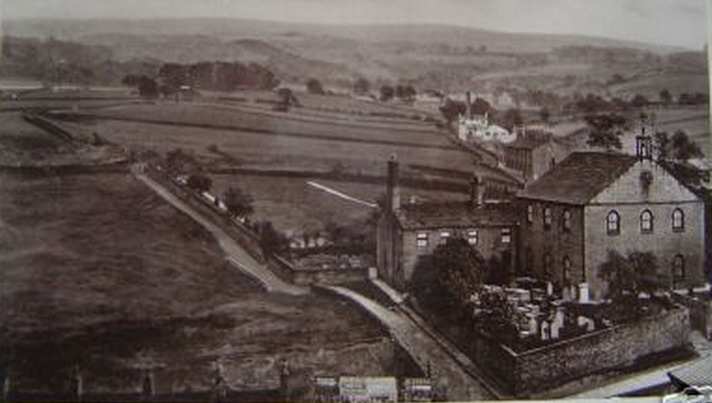
Other notable men to have preached in the new Chapel were John Barber, George Marsden, the great Dr Beaumont, Dr Hannah, Samuel Danks Waddy, Peter Mackenzie, John S. Simon, E Lloyd Jones, Marshall Randles and many famous laymen such as William Dawson (Billy Dawson) the Yorkshire orator; Edward Brooke (Squire Brooke) the popular preacher of Huddersfield; Isaac Linney, of Glossop, Isaac Marsden of Doncaster, a well known evangelist, Gipsy Smith and many others.
‘James Johnson of Furness Vale, was a most interesting personality, and had a most remarkable career. He preached his first and last sermon, 53 years later, in the United Methodist Chapel at Furness Vale. He was a collier, and his sermons were made in a coal mine. He read the bible through twice every year for the last nineteen years of his life. His sermons were replete with Biblical narrative and teaching and came from a soul all alive with a sense of the unseen. He was the most popular local preacher in the district, and young and old flocked to hear him. The fortitude he manifested under temporal difficulties, his general cheerfulness of spirit, his all but faultless Christian earnestness and generosity of disposition won him a place of high esteem in the minds of those who knew him best. Fortified by the Gospel he had long proclaimed to others, and bearing with quiet restfulness his last bodily affliction, he passed into eternal life September 6th 1901.
The chapel yard contains the graves of many of the town’s notable 19th century families including Samuel Schofield, of Warksmoor House. The Schofield’s built Warkmoor House and Torr Mill. The family of Armstrong lie there. They worked Torr Vale Mill. The Barnes, Thatchers, Arnfields, Bridges, Willans and Bennett’s, all industrialists. Also Stephen Beard, the composer of the well known tune ‘Ransom’ and Timothy Beard well known vocalist. The family of Hibbert, including Robert Hibbert, of Warksmoor who built the first cotton mill in Newtown and the houses now called Hibbert Street, which he named Newtown Buildings. When asked his reason for doing so he replied that there would be a new town there some day, and so it proved.
Wesleyanism, manifest today in Methodist and Holiness churches, is named for its founders, John and Charles Wesley. In 1736, these men travelled to the Georgia colony in America as missionaries for the Church of England; they left rather disheartened at what they saw. Both men then had "religious experiences", especially John in 1738, being greatly influenced by the Pietist movement. They began to organize a movement within the Church of England to focus on personal faith and holiness, and they succeeded. John Wesley took the Reformation churches to task over the nature of sanctification, the process by which a believer is made to conform to the image of Christ, and in many ways restored the New Testament teachings regarding the work of God and the believer in sanctification. The movement did well within the Church of England in Britain, but when the movement crossed the ocean into America, it took on a form of its own, finally being established as the Methodist Episcopal Church in 1784. The Wesleyan churches are very similar to Anglicanism, yet have added a strong emphasis on personal faith and personal experience.
For a fuller history of the Methodist Movement in New Mills see New Mills Wesleyanism by S.Evans.
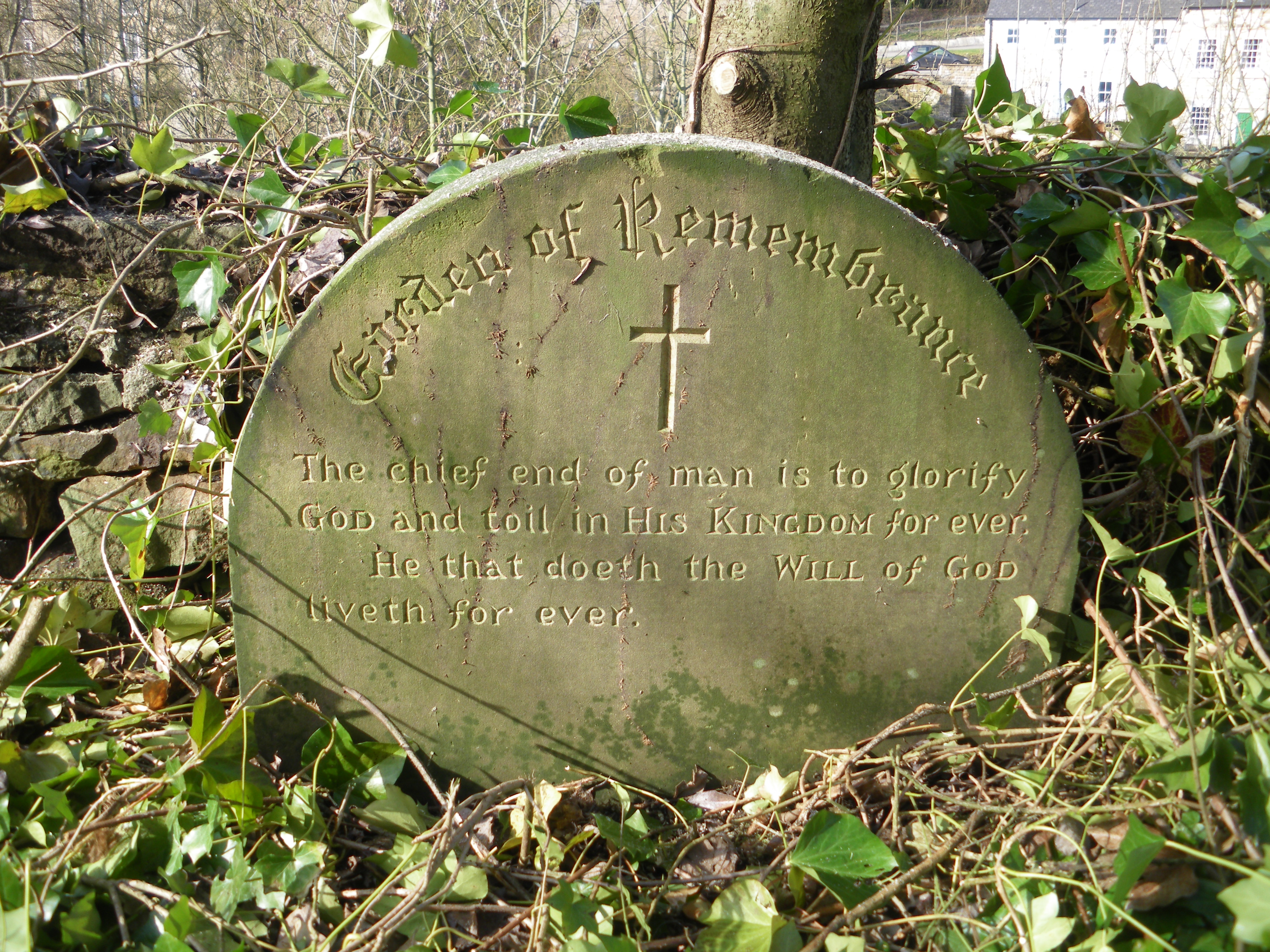
 | 






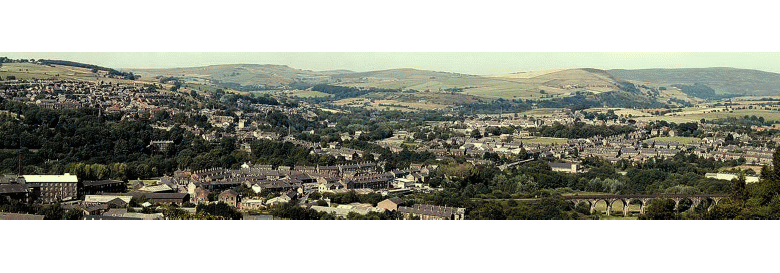



 Wesley’s first visit to New Mills was in 1768, two years after the erection of the first chapel and an entry in his Journal reads: ‘I rode to the little town called New Mills in the High Peak of Derbyshire. I preached at noon in their large new chapel, which (in consideration that preaching houses have need of air) has a casement in every window three inches square. That is the custom of the country!’
Wesley’s first visit to New Mills was in 1768, two years after the erection of the first chapel and an entry in his Journal reads: ‘I rode to the little town called New Mills in the High Peak of Derbyshire. I preached at noon in their large new chapel, which (in consideration that preaching houses have need of air) has a casement in every window three inches square. That is the custom of the country!’
